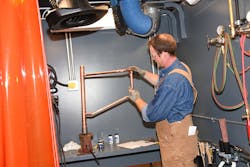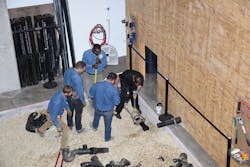Training for a Brighter Future
Plumbing contractors today are bombarded by new technology and ideas -- in the software they use in the office, in the apps they use on their mobile devices, and in the products they install and service. This series of articles will explain why training is critical for plumbing contractors in order to be competitive, successful and able to grow their businesses.
When a person decides to enter the plumbing profession, proper training is crucial not only for the success of the individual but for the safety of the public. Improper installation of plumbing systems can lead to contamination, disease and even death.
Plumbing apprentices can choose two routes to employment — union or nonunion shops. Each has its own apprenticeship training curriculum. While there are many outstanding training programs for the nonunion sector, union training for plumbers is regarded as the standard of excellence in the industry because of its structure and the breadth of learning.
The United Association of Journeymen and Apprentices of the Plumbing and Pipe Fitting Industry of the United States and Canada represents nearly 340,000 plumbers, pipefitters, sprinkler fitters, welders and service technicians in local unions across North America. It has the first nationally registered joint apprenticeship program in the United States, dating back to 1936.
UA apprenticeship training is a five-year program consisting of classroom education and on-the-job training. During the first three years, apprentices go to school one day a week and work for a local contractor the other four days. In the fourth and fifth years, apprentices have on-the-job training five days a week and attend night school classes from September until June.
“We have more than 600 apprentices going through our program right now,” says James Majerowicz, training director for Chicago Journeyman Plumbers Local Union 130. “It’s a very extensive training program where apprentices learn through classroom lecture and hands-on experience, and then see the same techniques applied at work.”
Local 130 has more than 6,000 members in the metro area and is one of the largest straight-line plumbing locals in the UA. It has three training centers — downtown Chicago; Volo, Ill.; and Joliet, Ill. The new Chicago 50,000-sq.-ft. training center opened in September and is equipped with green technologies such as rainwater harvesting, solar energy and grey water systems.
At the dedication event for the opening of the Chicago Journeyman Plumbers Local Union 130’s new 50,000-sq.-ft. training center in downtown Chicago, visitors watched as plumbers demonstrated how to install underground drain waste and vent. The Chicago is one of three training centers the union operates. Photo credit: Chicago Journeyman Plumbers Local Union 130
In addition to those eco-friendly technologies, apprentices learn the safe, correct and efficient installation and maintenance of systems such as underground water supply, storm water, sewer drainage, fixture installation, and waste and vent piping both inside and outside of commercial buildings and residential homes. The learn how to read blueprints and effectively communicate with customers.
Majerowicz is a 39-year veteran of the plumbing industry and has spent 27 of those years teaching. “There’s no better job than teaching,” he says. “When you’re a journeyman plumber, you’re a teacher from the get-go because you’re teaching apprentices.”
When the union asked Majerowicz to apply for a teaching position, he did and was hired immediately. Twenty-five years later, he was named Local 130’s training director.
In addition to apprentice training, Local 130 also has journeyman classes that run in its night school program. “In Illinois, a licensed journeyman plumber has to have four hours of continuing education annually,” Majerowicz explains. “We offer those classes once a month at all three locations.”
Attendees at the Chicago Journeyman Plumbers Local Union 130 dedication event saw demonstrations of the different equipment that apprentices learn to use as part of their training, including how to fabricate copper piping. Local 130 has more than 6,000 members in the metro area and is one of the largest straight-line plumbing locals in the UA. Photo credit: Chicago Journeyman Plumbers Local Union 130
Much of the technical aspects of training are enhanced by the cooperation of plumbing manufacturers, who supply training material, training equipment and technical information, as well as demonstrations of their products, Majerowicz notes. “We work very closely with manufacturers and manufacturers reps to keep our apprentices on the cutting-edge of all the new products and the existing products the manufacturers have,” he says.
Majerowicz believes training is an ongoing endeavor, and he notes that more contractors are seeking training for all their field employees. However, it’s teaching apprentices the intricacies of the plumbing profession that gives him a sense of accomplishment — and pride.
“Apprentices are the future of our industry,” Majerowicz notes. “The more knowledge we can relay to our apprentices, the brighter our future is going to be.”


